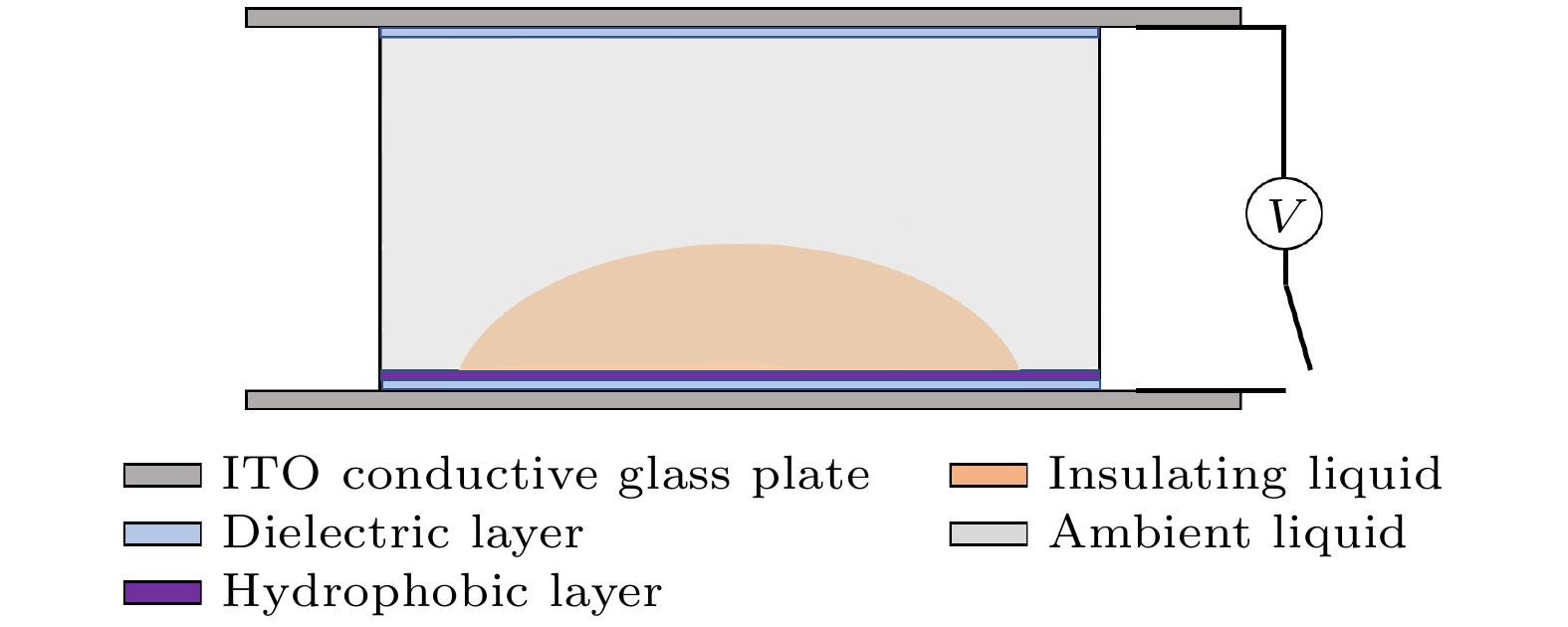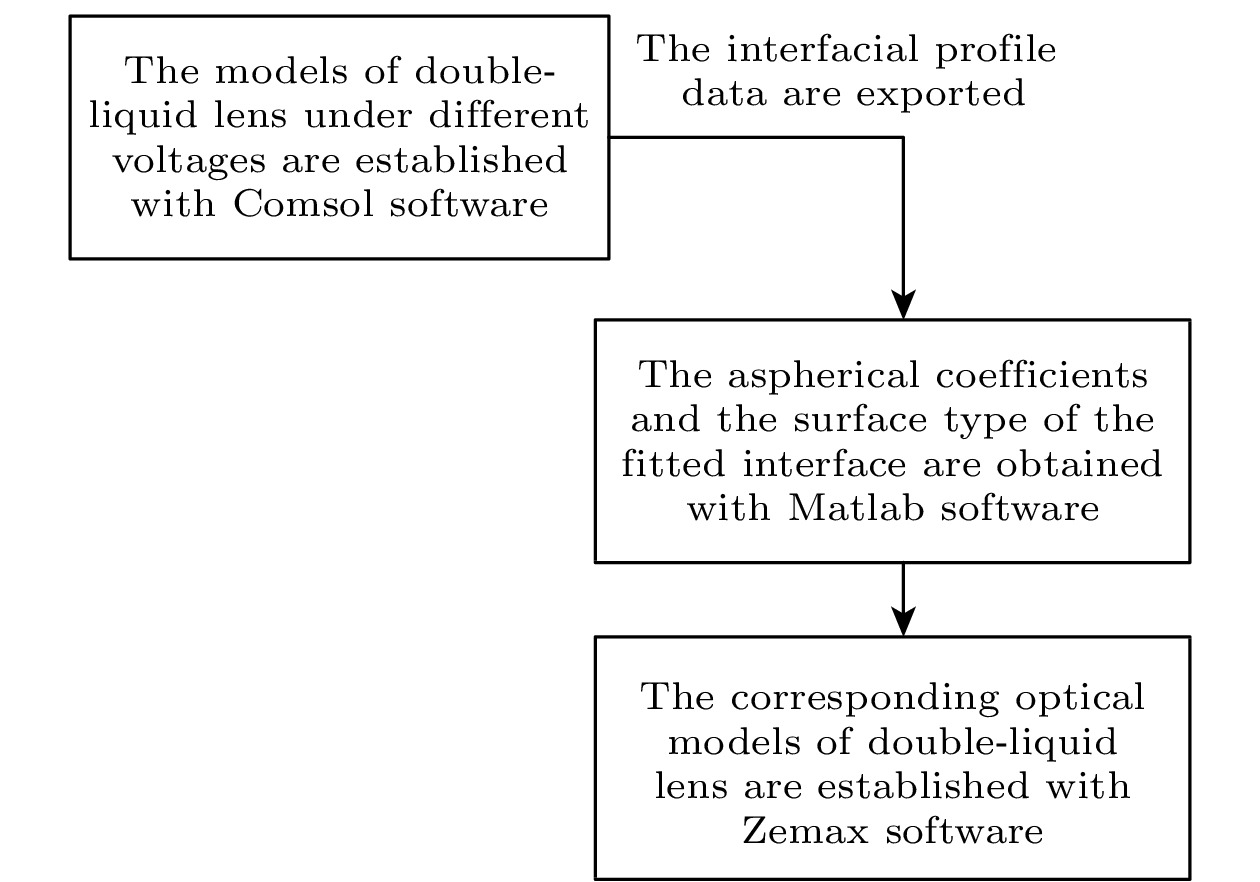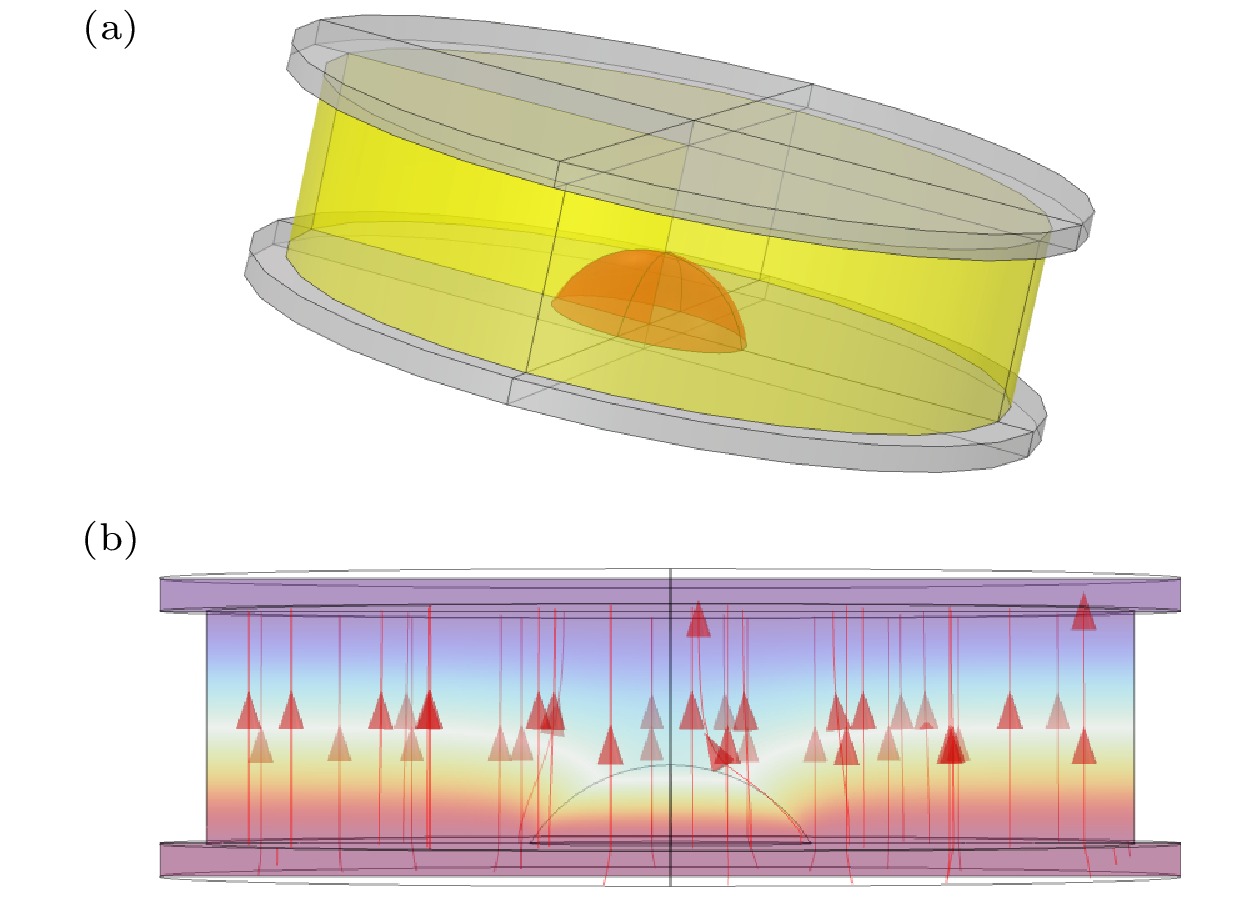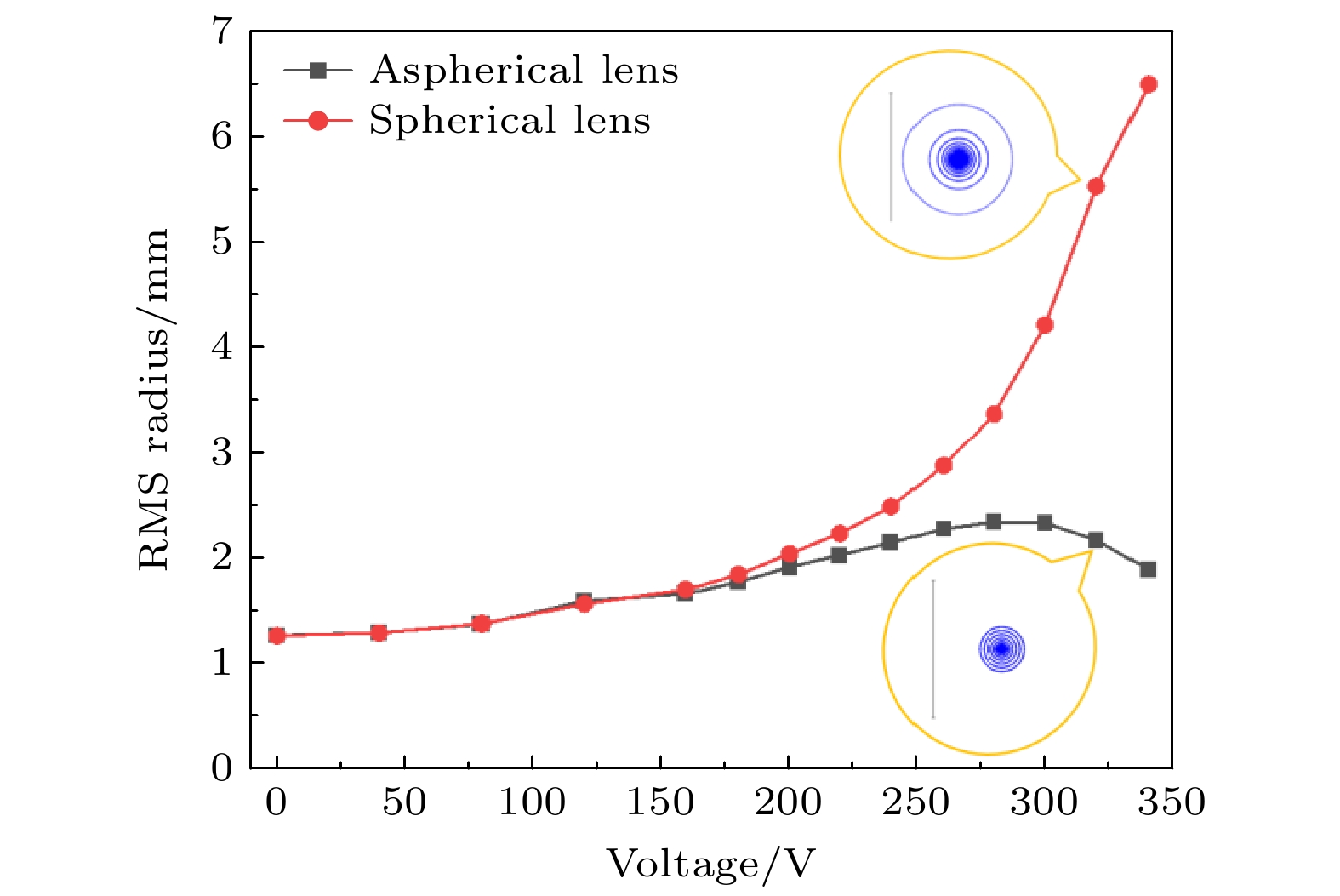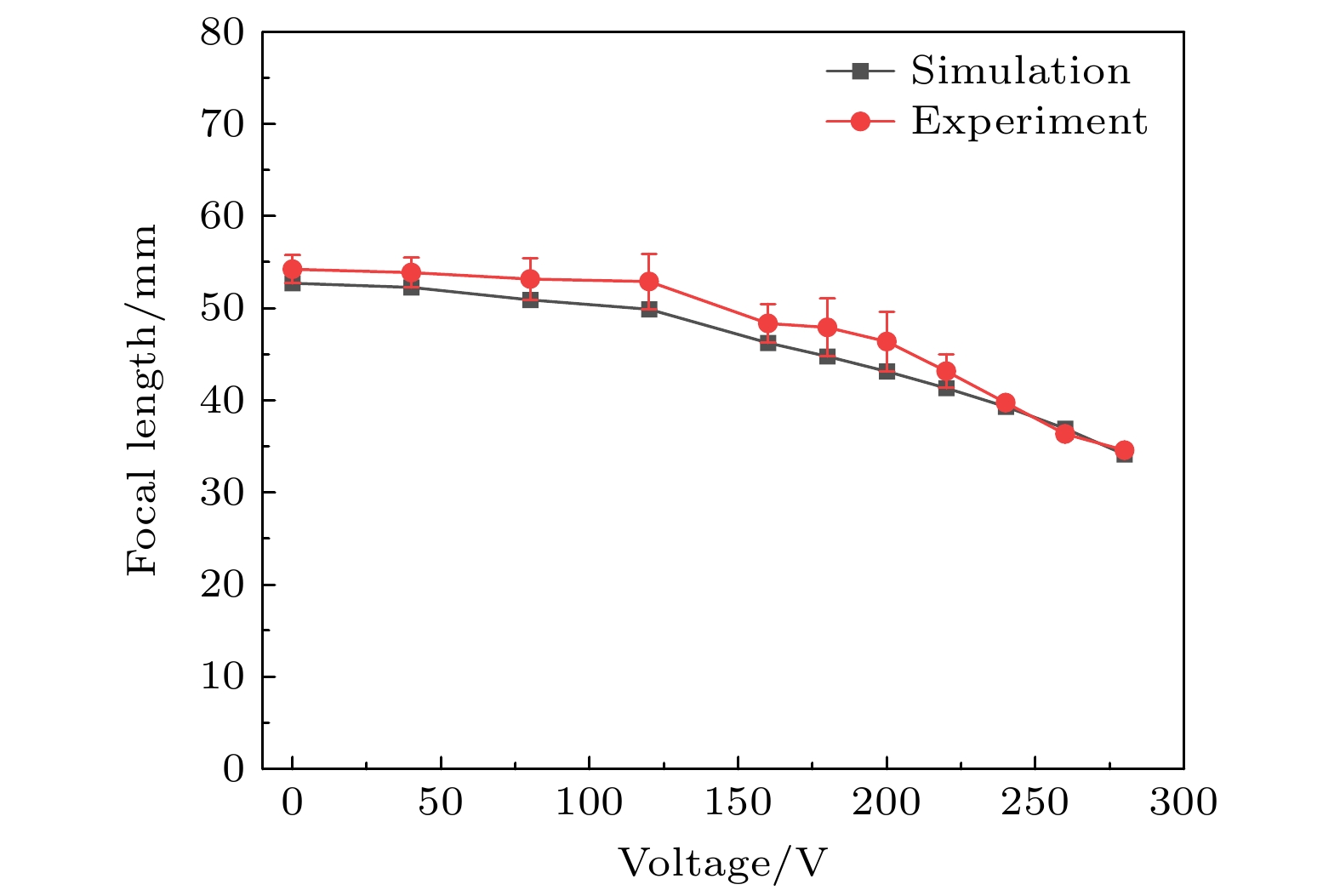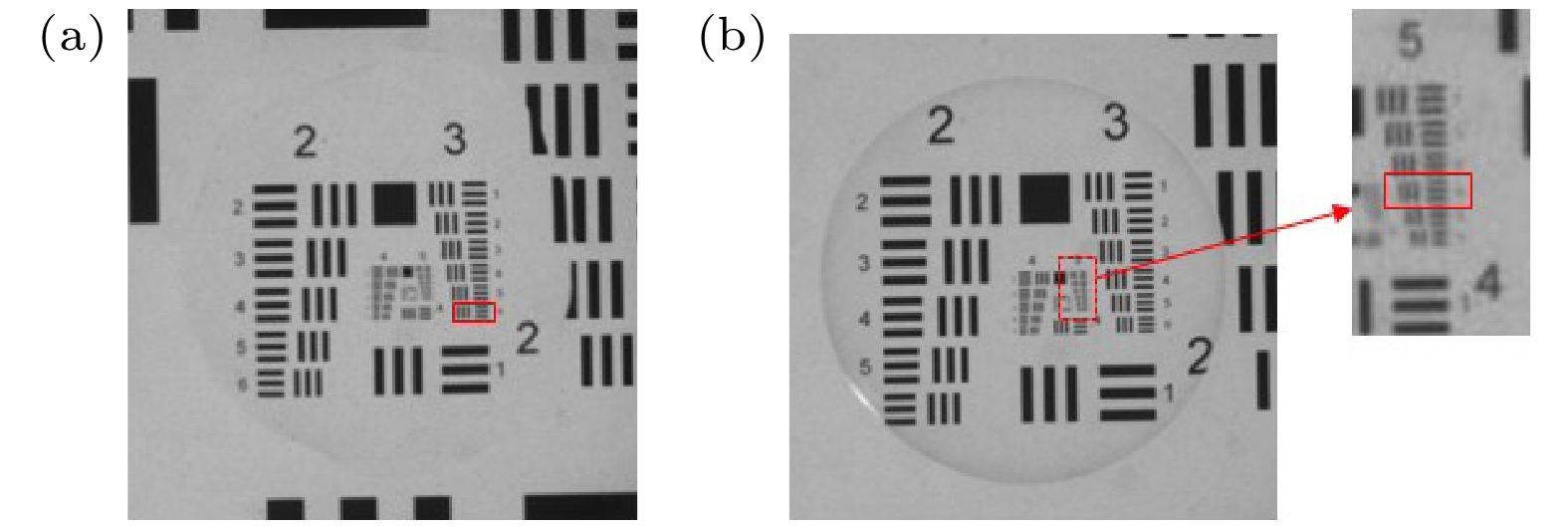-
应用介电泳原理, 设计了一种基于平行平板电极的非球面双液体透镜, 具有结构简单和易于实现的优点. 利用Comsol, Matlab和Zemax软件, 建立了相应的非球面双液体透镜光学模型, 仿真分析了其在不同电压下的焦距变化及成像特性, 并与球面双液体透镜模型进行了比较分析. 非球面双液体透镜的变焦范围大于球面的, 前者的成像质量亦优于后者. 而且, 实验制备了该非球面双液体透镜器件, 结果表明, 在工作电压为0—280 V时, 焦距变化为54.2391—34.5855 mm, 与仿真结果基本相符, 而且该器件的成像分辨率最大可达45.255 lp/mm.According to the principle of dielectrophoresis, an aspherical double-liquid lens based on parallel plate electrodes is designed. In comparison with the liquid lenses based on patterned-electrodes, the aspherical double-liquid lens structure uses continuous electrodes, which have the advantages of simpler processing, lower cost, easier realization and more practicability. The droplet in the dielectric electrophoretic liquid lens is polarized in the electric field and moves towards the higher electric field intensity under the action of the dielectrophoretic force. With the change of applied voltage, the dielectrophoretic force varies, thus the contact angle of the droplet at the liquid-liquid interface is changed. Firstly, the models of aspherical double-liquid lenses under different voltages are established with Comsol software, and the data of interfacial profile are derived. Then using Matlab software, the derived interface surface data are fitted by polynomial, and the aspherical coefficients are obtained. Finally, the optical models are built with Zemax software, and the variation range of focal length and root mean square (RMS) radius of aspherical double-liquid lens under different voltages are analyzed. In order to further study the characteristics of aspherical double-liquid lens, it is compared with spherical double-liquid lens model. The liquid material, cavity structure and droplet volume of spherical double-liquid lens are consistent with those of aspherical double-liquid lens. The corresponding spherical double-liquid lens model is established by using the Zemax software, the range of focal length and RMS radius of spherical double-liquid lens under different voltages are obtained. The results show that the focal length variation range of aspherical double-liquid lens is larger than that of spherical double-liquid lens, and the imaging quality of the former is better than that of the latter. The experimental preparation of the designed aspherical double-liquid lens device is carried out, and its focal length and imaging resolution are measured. When the operating voltage is in a range of 0–280 V, the focal length varies from 54.2391 to 34.5855 mm, which is basically consistent with the simulation result. The feasibility of the liquid lens structure is verified experimentally. The imaging resolution can reach 45.255 lp/mm. The designed aspherical double-liquid lens based on the parallel plate electrode can provide a new scheme for the high-quality imaging of liquid lens and its application, and can expand the application scope of liquid lens.
[1] Sim J H, Kim J, Kim C, Shin D, Lee J, Koo G, Jung G S, Won Y H 2018 Sci. Rep. 8 15416
 Google Scholar
Google Scholar
[2] Cai H, Poon A W 2010 Opt. Lett. 35 2855
 Google Scholar
Google Scholar
[3] Seo S W, Han S, Seo J H, Kim Y M, Kang M S, Min N K, Choi W B, Sung M Y 2009 Jpn. J. Appl. Phys. 48 052404
 Google Scholar
Google Scholar
[4] López C A, Lee C C, Hirsa A H 2005 Appl. Phys. Lett. 87 134102
 Google Scholar
Google Scholar
[5] Ashtiani A O, Jiang H 2013 Appl. Phys. Lett. 103 111101
 Google Scholar
Google Scholar
[6] Zhao P, Ataman C, Zappe H 2015 Opt. Express 23 21264
 Google Scholar
Google Scholar
[7] Mishra K, Murade C, Carreel B, Roghair I, Oh J M, Manukyan G, Van Den Ende D, Mugele F 2014 Sci. Rep. 4 6378
 Google Scholar
Google Scholar
[8] Li L, Wang J H, Wang Q H, Wu S T 2018 Opt. Express 26 25839
 Google Scholar
Google Scholar
[9] Jin B, Xu M, Ren H, Wang Q H 2014 Opt. Express 22 31041
 Google Scholar
Google Scholar
[10] Xu M, Xu D, Ren H, Yoo I S, Wang Q H 2014 J. Opt. 16 105601
 Google Scholar
Google Scholar
[11] Wang J H, Zhou X, Luo L, Yuan R Y, Wang Q H 2019 Opt. Commun. 445 56
 Google Scholar
Google Scholar
[12] Zhang C Y, Li L, Wang Q H 2017 J. Soc. Inf. Display 25 331
 Google Scholar
Google Scholar
[13] Hung K Y, Tseng F G, Liao T H 2008 J. Microelectromech. Syst. 17 370
 Google Scholar
Google Scholar
[14] Yu H, Zhou G, Leung H M, Chau F S 2010 Opt. Express 18 9945
 Google Scholar
Google Scholar
[15] Mishra K, Mugele F 2016 Opt. Express 24 14672
 Google Scholar
Google Scholar
[16] Lima N C, Mishra K, Mugele F 2017 Opt. Express 25 6700
 Google Scholar
Google Scholar
[17] Mishra K, Narayanan A, Mugele F 2019 Opt. Express 27 17601
 Google Scholar
Google Scholar
[18] Chen Q, Tong X, Zhu Y, Tsoi C C, Jia Y, Li Z, Zhang X 2020 Lab Chip 20 995
 Google Scholar
Google Scholar
[19] Kong M M, Zhu L F, Chen D, Liang Z C, Zhao R, Xu E M 2016 J. Opt. Soc. Korea 20 427
 Google Scholar
Google Scholar
[20] Kong M M, Chen X, Yuan Y, Zhao R, Chen T, Liang Z C 2019 Curr. Opt. Photonics 3 177
 Google Scholar
Google Scholar
[21] Wu S T, Ren H 2012 Introduction to adaptive lenses (Hoboken: Willey) pp148–108
[22] 孔梅梅, 潘世成, 袁东, 孙小波, 薛银燕, 赵瑞, 陈陶 2023 激光与光电子学进展 60 192202
 Google Scholar
Google Scholar
Kong M M, Pan S C, Yuan D, Sun X B, Xue Y Y, Zhao R, Chen T 2023 Laser Optoelectron. Progr. 60 192202
 Google Scholar
Google Scholar
[23] 孔梅梅, 刘悦, 董媛, 薛银燕, 潘世成, 赵瑞 2023 72 154206
 Google Scholar
Google Scholar
Kong M M, Liu Y, Dong Y, Xue Y Y, Pan S C, Zhao R 2023 Acta Phys. Sin. 72 154206
 Google Scholar
Google Scholar
[24] 梁丹 2022 硕士学位论文 (南京: 南京邮电大学)
Liang D 2022 M. S. Thesis (Nanjing: Nanjing University of Posts and Telecommunications
[25] Ren H, Xianyu H, Xu S, Wu S T 2008 Opt. Express 16 14954
 Google Scholar
Google Scholar
[26] Xu M, Liu Y T, Yuan Y, Lu H B, Qiu L Z 2022 Opt. Lett. 47 509
 Google Scholar
Google Scholar
-
表 1 不同工作电压下面型拟合精度(R-Square值)
Table 1. Precision of surface fitting under different working voltages (R-Square value).
电压/V R-Square值 0 0.9998 40 0.9998 80 0.9998 120 0.9998 160 0.9997 200 0.9996 240 0.9993 280 0.9987 320 0.9968 -
[1] Sim J H, Kim J, Kim C, Shin D, Lee J, Koo G, Jung G S, Won Y H 2018 Sci. Rep. 8 15416
 Google Scholar
Google Scholar
[2] Cai H, Poon A W 2010 Opt. Lett. 35 2855
 Google Scholar
Google Scholar
[3] Seo S W, Han S, Seo J H, Kim Y M, Kang M S, Min N K, Choi W B, Sung M Y 2009 Jpn. J. Appl. Phys. 48 052404
 Google Scholar
Google Scholar
[4] López C A, Lee C C, Hirsa A H 2005 Appl. Phys. Lett. 87 134102
 Google Scholar
Google Scholar
[5] Ashtiani A O, Jiang H 2013 Appl. Phys. Lett. 103 111101
 Google Scholar
Google Scholar
[6] Zhao P, Ataman C, Zappe H 2015 Opt. Express 23 21264
 Google Scholar
Google Scholar
[7] Mishra K, Murade C, Carreel B, Roghair I, Oh J M, Manukyan G, Van Den Ende D, Mugele F 2014 Sci. Rep. 4 6378
 Google Scholar
Google Scholar
[8] Li L, Wang J H, Wang Q H, Wu S T 2018 Opt. Express 26 25839
 Google Scholar
Google Scholar
[9] Jin B, Xu M, Ren H, Wang Q H 2014 Opt. Express 22 31041
 Google Scholar
Google Scholar
[10] Xu M, Xu D, Ren H, Yoo I S, Wang Q H 2014 J. Opt. 16 105601
 Google Scholar
Google Scholar
[11] Wang J H, Zhou X, Luo L, Yuan R Y, Wang Q H 2019 Opt. Commun. 445 56
 Google Scholar
Google Scholar
[12] Zhang C Y, Li L, Wang Q H 2017 J. Soc. Inf. Display 25 331
 Google Scholar
Google Scholar
[13] Hung K Y, Tseng F G, Liao T H 2008 J. Microelectromech. Syst. 17 370
 Google Scholar
Google Scholar
[14] Yu H, Zhou G, Leung H M, Chau F S 2010 Opt. Express 18 9945
 Google Scholar
Google Scholar
[15] Mishra K, Mugele F 2016 Opt. Express 24 14672
 Google Scholar
Google Scholar
[16] Lima N C, Mishra K, Mugele F 2017 Opt. Express 25 6700
 Google Scholar
Google Scholar
[17] Mishra K, Narayanan A, Mugele F 2019 Opt. Express 27 17601
 Google Scholar
Google Scholar
[18] Chen Q, Tong X, Zhu Y, Tsoi C C, Jia Y, Li Z, Zhang X 2020 Lab Chip 20 995
 Google Scholar
Google Scholar
[19] Kong M M, Zhu L F, Chen D, Liang Z C, Zhao R, Xu E M 2016 J. Opt. Soc. Korea 20 427
 Google Scholar
Google Scholar
[20] Kong M M, Chen X, Yuan Y, Zhao R, Chen T, Liang Z C 2019 Curr. Opt. Photonics 3 177
 Google Scholar
Google Scholar
[21] Wu S T, Ren H 2012 Introduction to adaptive lenses (Hoboken: Willey) pp148–108
[22] 孔梅梅, 潘世成, 袁东, 孙小波, 薛银燕, 赵瑞, 陈陶 2023 激光与光电子学进展 60 192202
 Google Scholar
Google Scholar
Kong M M, Pan S C, Yuan D, Sun X B, Xue Y Y, Zhao R, Chen T 2023 Laser Optoelectron. Progr. 60 192202
 Google Scholar
Google Scholar
[23] 孔梅梅, 刘悦, 董媛, 薛银燕, 潘世成, 赵瑞 2023 72 154206
 Google Scholar
Google Scholar
Kong M M, Liu Y, Dong Y, Xue Y Y, Pan S C, Zhao R 2023 Acta Phys. Sin. 72 154206
 Google Scholar
Google Scholar
[24] 梁丹 2022 硕士学位论文 (南京: 南京邮电大学)
Liang D 2022 M. S. Thesis (Nanjing: Nanjing University of Posts and Telecommunications
[25] Ren H, Xianyu H, Xu S, Wu S T 2008 Opt. Express 16 14954
 Google Scholar
Google Scholar
[26] Xu M, Liu Y T, Yuan Y, Lu H B, Qiu L Z 2022 Opt. Lett. 47 509
 Google Scholar
Google Scholar
计量
- 文章访问数: 3657
- PDF下载量: 102
- 被引次数: 0














 下载:
下载:
